Guitar
I come across a lot of guitars that have been strung badly. If the strings are not put on correctly there is little chance of the instrument staying in tune. Its surprising how many players get it wrong - even pros.
The idea is to get at least 3 tight, neat turns down the post. The correct method not only ensures tuning stability but makes it easy to remove a broken string.
If you break a string on stage the first problem is removing the old string. If it is tied in some kind of knot or pushed through the hole twice then you've got a problem. Combine that with limited time and visibility, sweaty hands and adrenalin and often alcohol and you've got a right old struggle on your hands. And that's just getting the old one off.
You don't need a knot, it only serves to create loops of string and this 'free play' causes tuning problems.
I have a method I prefer for all steel strung guitars. Its not the only way to fit strings but I find it very quick and effective, tuning stable and easy to remove strings when I have to. I can fit the strings a couple of hours before a gig and be confident they'll stay in tune.
I first remove the old strings and clean and oil the fingerboard.
I ideally want to get 3 neat, tight turns of string down the post. It can be hard to know how much string to leave that will achieve this so I've devised a super high tech method. I measure the width of three fingers of string past the post, kink the string and spip it off about 8mm from the bend. The three fingers gives me about three turns - I think of it as a 'rule of thumb' arf arf.
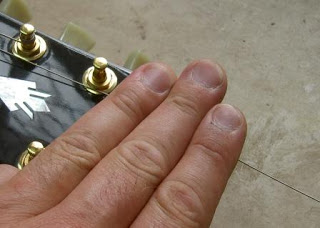
This picture shows me measuring the D string 3 fingers past the tuning post.
I then make a kink in the string at the 3 finger mark
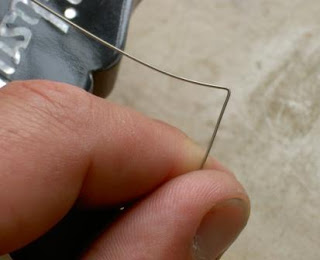
This needs to be 90 degrees or a little less.
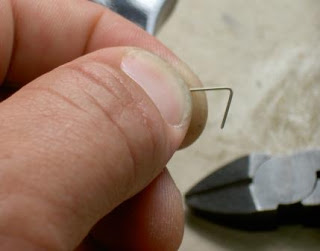
I then snip the string off using side cutters leaving about 10mm after the kink.
This leaves me just enough string for 3 neat turns around the post.
I often measure just less than 3 fingers for the bass strings and a little over 3 for the treble.
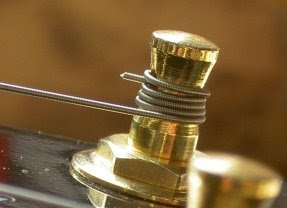
Once all the strings are on I tune them andd give them a good stretch a couple of time
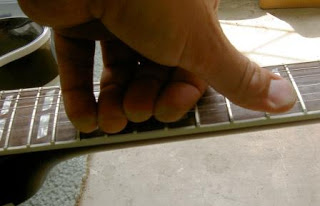
A quick check of the intonation and the guitar is ready for a gig.
………………………………………………………………………………………….
Feel free to contact me about repair work (if you are in NZ). I only check emails weekly so the workshop phone is always the best 09 307 6501.
- Gibson Tennessee Nut Repair
This is an unusual guitar - It's a 1990 Gibson Tennessee Chet Atkins model. Here's the serial number, the first and fifth number tell me the year. I think it was '76 they started this system. Gibson's website is good for dating...
- New Zealand Music Month
. I'm going to do my best to get out and see more live music in May. There are so many of my customers I've never seen play live.Check out http://www.nzmusicmonth.co.nz/ for what's going on.Looks like I'm in for a busy month keeping...
- Guild D40 Bridge Saddle
This is a beautiful Guild D40 from 1977. The customer is a pro player and bought the guitar new in Sydney. It hasn't been played a huge amount and its in great condition. The problem is with the intonation - its not out a huge amount but enough...
- Strat Pick-up Height
I come accross Strats and Teles a lot - I'm a Fender player myself. Its very common for the pick-up height to be adjusted incorrectly. Its something that's easy to sort out and can make a big difference to your sound. If the pick-up is too...
- Reverend 'warhawk' Set-up
I do a lot of work for 'poolside studios'. They importvarious makes of musical stuff including 'Top Hat' amps, 'Eastwood' guitars and 'Reverend' guitars. All their guitars that come into New Zealand get checked over by...
Guitar
Stringing a Guitar
I come across a lot of guitars that have been strung badly. If the strings are not put on correctly there is little chance of the instrument staying in tune. Its surprising how many players get it wrong - even pros.
The idea is to get at least 3 tight, neat turns down the post. The correct method not only ensures tuning stability but makes it easy to remove a broken string.
If you break a string on stage the first problem is removing the old string. If it is tied in some kind of knot or pushed through the hole twice then you've got a problem. Combine that with limited time and visibility, sweaty hands and adrenalin and often alcohol and you've got a right old struggle on your hands. And that's just getting the old one off.
You don't need a knot, it only serves to create loops of string and this 'free play' causes tuning problems.
I have a method I prefer for all steel strung guitars. Its not the only way to fit strings but I find it very quick and effective, tuning stable and easy to remove strings when I have to. I can fit the strings a couple of hours before a gig and be confident they'll stay in tune.
I first remove the old strings and clean and oil the fingerboard.
I ideally want to get 3 neat, tight turns of string down the post. It can be hard to know how much string to leave that will achieve this so I've devised a super high tech method. I measure the width of three fingers of string past the post, kink the string and spip it off about 8mm from the bend. The three fingers gives me about three turns - I think of it as a 'rule of thumb' arf arf.

This picture shows me measuring the D string 3 fingers past the tuning post.
I then make a kink in the string at the 3 finger mark

This needs to be 90 degrees or a little less.

I then snip the string off using side cutters leaving about 10mm after the kink.
This leaves me just enough string for 3 neat turns around the post.
I often measure just less than 3 fingers for the bass strings and a little over 3 for the treble.

Once all the strings are on I tune them andd give them a good stretch a couple of time

A quick check of the intonation and the guitar is ready for a gig.
………………………………………………………………………………………….
Feel free to contact me about repair work (if you are in NZ). I only check emails weekly so the workshop phone is always the best 09 307 6501.
Workshop Hours
Mon……. 8-6
Tues……. 8-6
Wed…….. Closed
Thurs …..8-6
Fri ……….8-6
Sat/Sun ..Closed
Tues……. 8-6
Wed…….. Closed
Thurs …..8-6
Fri ……….8-6
Sat/Sun ..Closed
Mr Glyn’s Guitars
21a Khyber Pass Road
Auckland
New Zealand
http://www.mrglyn.co.nz/
www.facebook.com/MrGlynGuitars
www.mrglyn.blogspot.com
09 307 6501, 021 912678
- Gibson Tennessee Nut Repair
This is an unusual guitar - It's a 1990 Gibson Tennessee Chet Atkins model. Here's the serial number, the first and fifth number tell me the year. I think it was '76 they started this system. Gibson's website is good for dating...
- New Zealand Music Month
. I'm going to do my best to get out and see more live music in May. There are so many of my customers I've never seen play live.Check out http://www.nzmusicmonth.co.nz/ for what's going on.Looks like I'm in for a busy month keeping...
- Guild D40 Bridge Saddle
This is a beautiful Guild D40 from 1977. The customer is a pro player and bought the guitar new in Sydney. It hasn't been played a huge amount and its in great condition. The problem is with the intonation - its not out a huge amount but enough...
- Strat Pick-up Height
I come accross Strats and Teles a lot - I'm a Fender player myself. Its very common for the pick-up height to be adjusted incorrectly. Its something that's easy to sort out and can make a big difference to your sound. If the pick-up is too...
- Reverend 'warhawk' Set-up
I do a lot of work for 'poolside studios'. They importvarious makes of musical stuff including 'Top Hat' amps, 'Eastwood' guitars and 'Reverend' guitars. All their guitars that come into New Zealand get checked over by...
